This is a look at an early 70 mm widescreen process developed by the Fox Film Company in 1929 which led to the motion picture "The Big Trail".
Arguably the most widely known early large format motion picture is French director Abel Gance 1927 biography "Napoleon". Although this silent motion picture was shot mainly in 35 mm. The climatic battle sequence in this 330 minute picture was shot in a process that looks closer to "Cinerama" than modern"Widescreen", Gance called his process "Polyvision". He used three cameras to film a sequence, or combination of sequences that three projectors would in turn project onto a large screen after editing. The aspect aspect ratio of this process was 4 to 1.
Widescreen was not a new idea even in 1927 France. The first motion picture in a widescreen process was actually of the James J, Corbett and Bob Fitzsimmons boxing match. The documentary was released May 22, 1897 and ran 100 minutes. The picture had an aspect ratio of 1,65 to 1 and was shot on 63 mm nitrate film stock.

Also in 1927 a company called Natural Vision Pictures made an early widescreen film "The American" aka: "The Flag Wavier". The movie is lost to us and all we know is that it starred Bessie Love (1925's "The Lost World) and Charles Edgar Ray. Looking at biographical sketches of Love and Ray they both note this motion picture was never released theatrically. Which probably explains why it became lost. Another lost film by the same company, but released theatrically was a look at "Niagara Falls". Both productions were filmed on 63.5 mm stock and had aspect ratios of 2 to 1. Which brings me to the Fox Film Company.
Founded by William Fox on February 1, 1915 by the creator of the first newsreel "Fox Movie Tones".
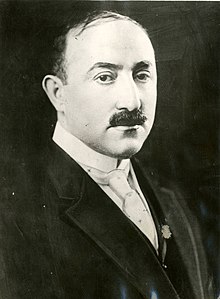
In 1929 William Fox developed a 70 mm process he called "Grandeur" which had a 2 to 1 aspect ratio as compared to the normal 35 mm film stock. aspect ration of 3 to 2,
The following link is to an article written in 1930 by Cinematographer Arthur Edeson for the September issue of "American Cinematographer". This article contains technical information on how he shot "The Big Trail" in the "Grandeur" process and how it compares to a regular 35 mm shoot. The motion picture is the only surviving film in this process and I'll speak of it later in this article. Anyone interested in this historic movie should read Mr.Edeson's one page article.
http://www.widescreenmuseum.com/widescreen/grandeur-sep1930.htm
An interesting point made in the article is Arthur Edeson's reference to two shoots of "The Big Trail" one in 35 mm and one in the 70 mm "Grandeur" process. The problem with "Grandeur" is that you needed that special camera to shoot it, a special projector to show it and of course a movie screen that could handle the size of the film. The standard screen at the time was 24x18 feet as compared to the 42x20 foot screen required for widescreen motion pictures. In short, if a theater owner wanted to show a film in 70 mm he had to make costly changes to his operation.
Previously to "The Big Trail" Fox had shot some of their "Movie Tone" newsreel shorts in 70 mm. Along with three "pre-code" motion pictures. The first picture was known by three names that appeared on different prints: "Fox Movie Tone Follies of 1929" aka: "Movie Tone Follies of 1929" and on a bit of an ego trip "The William Fox Movie Tone Follies of 1929", This movie was a combination of black and white and color presentations. It is also considered a lost film.
Fox's musical "Happy Days" released September 17, 1929 was the first motion picture entirely shot in widescreen that would be released worldwide. As I said Abel Gance's "Napoleon" had just one sequence in "Polyvision", Gance's film wasn't the first commercial film with widescreen associated with it. Paramount had released in 1927 the motion picture "Old Ironsides" that contained two sequences in what was called "Magnascope" and in 1928 MGM released "Trail of 98" in a process called "Fanthom Screen", The Paramount and MGM films were both silent.
Among those appearing in the 1929 "Happy Days" were Will Rodgers, Victor McLagen, Janet Gayner and as a chorus girl 12 year old Betty Grable. In 1930 Fox made another lost film "Song o' My Heart" which features a young Maureen O'Sullivan. Who like Betty Grable was headed for stardom., In Sullivan's case first opposite Johnny Weismuller in a MGM "Tarzan" series as "Jane".
William Fox received honors from the film industry over "Grandeur" and it appeared that widescreen motion pictures were going to be the way the studios would be making movies from 1930 forward. Then two events occurred which changed not only the movie industry, but the country. The first was October 24, 1929 known forever as "Black Thursday" as the Stock Market crashed. That event help start "The Great Depression" that destroyed families and people lives. Even as things kept getting worse audiences would find the money to see movies to escape reality for an hour, or so. However, now the theater owners had no money to convert their operations to the "Grandeur" format.
William Fox's company was facing a hostile takeover in 1930 and bankruptcy. This had started with his near fatal car accident in 1929 and was followed by the Stock Market Crash. Fox would battle the take over, but loose in 1935. His the final court battle was in 1936. When William Fox attempted to bribe Judge John Warren Davis and also committed perjury. He was sentenced and spent six months in jail. His company was merged in 1935 with "Twentieth Century Pictures" to form "20th Century Fox",
After William Fox was released from jail he retired from the Motion Picture Industry and in 1952 died almost unnoticed and unknown. Not one representative of any film studio. Let alone "20th Century Fox" attended his funeral in New York. Irony always plays a part in events.
One year after his death "20th Century Fox" would release a movie called "The Robe" in a process they named "CinemaScope". Initially it had an aspect ration of 2.35 to 1. This was nothing more than William Fox's "Grandeur" refined with modern technology. Thanks to a lenses development for "20th Century Fox" by Bausch and Lomb. All the studio needed to do was place this lenses on any motion picture camera and it would shoot in the "CinemaScope" format onto film. While all the theater owner had to do was place a second lenses on any projector to project the film. There was no need for special camera and projector equipment as with "Grandeur". The biggest outlay a movie theater owner had was to enlarge his screen size.
While the original drama of creating "Grandeur" was going on back in 1930. A Western was being made by the Fox Corporation that would become famous in several ways. Two of these are that it is is the only remaining motion picture in William Fox's "Grandeur" process and another dealt with an unknown prop boy who was given the lead.
Ok, let's do the second first, as there are several versions of the story. Born on May 26, 1907 was Marion Robert Morrison. However, his parents decided to name their next son Robert and to avoid confusion Marion's middle name was changed to Mitchell. The boy was now Marion Mitchell Morrison and would attend the University of Southern California as Michael Robert Morrison, or some say, Marion Robert Morrison.
There are several versions of how he got his nickname "Duke". The most widely told is that a local fireman always saw Marion walking to school in Glendale, California with his Airedale Terrier "Duke" and he started calling him "Little Duke". Marion liked the nickname rather than his own. Another variation is that it was his father and not a fireman.
Another story is told by his USC football team mate Ward Bond. According to Bond it was the team that gave Wayne the nickname. Although Bond never said the actual reason for this and may have been trying to be part of the legend. Then there is a fun version that comes from John Wayne himself. He was in a series of six remakes of silent film cowboy Ken Maynard's westerns. They even had Wayne dress like Maynard so footage from the original silents could be used and his horse was also an exact copy of Maynard's. Whenever Wayne was asked were the nickname "Duke" came from. He was known for awhile to reply: "Hell, they named the horse Duke". Referring to the horse's billing in these westerns as "Duke the Devil Horse".
So take your pick and I've read others as well.
After Fox gave the "Greenlight" to film the western "The Big Trail" the question arose as to who would play the lead "Breck Coleman". The movies director Raul Walsh, who had played John Wilkes Booth in D.W. Griffith's classic and controversial "The Birth of a Nation', asked Gary Cooper. Cooper declined because of a previous commitment. |
Speaking of nicknames below is a photo of "One Eyed" Raul Walsh
Walsh then asked his friend and fellow director John Ford for ideas. Ford suggested a young extra who was also the prop boy on many of his films. In 1929 the young extra had been billed in the lost musical "Words and Music" as "Duke" Morrison.
Supposedly Ford told Walsh that he:
liked the looks of this new kid with a funny walk, like he owned the world.According to Harry Carey, Jr. in his excellent book "Company of Heroes: My Life in the John Ford Stock Company". It was his father silent cowboy star Harry Carey, who got character actor and acting teacher, Paul Fix, to teach the future cowboy icon how to "Walk like a Cowboy" and stop that funny walk!
Now we come to the name. Once more the stories vary, but according to Raul Walsh. There was no way the lead actor in a western was going to be named "Marion". Walsh suggested the name "Anthony Wayne" to Fox Studio chief Winfield Sheehan. Sheehan rejected it as sounding "too Italian", but as Walsh, an American History scholar, knew the name belonged to "Mad" Anthony Wayne one of the finest Revolutionary War heroes for the future United States. Walsh next suggested changing the first name to "John" and Sheehan agreed. However,
Another version of this tale has no mention of John Ford and just states that while walking across the Fox Studio Lot. Raul Walsh saw the future John Wayne moving props and thought he looked like the perfect frontier scout for his movie.
Another part of the legend says the now named John Wayne admitted his inexperience in acting and Walsh was supposed to have advised him to just:
sit good on a horse and point.
Below the new actor John Wayne is shown part of the Fox Companies gun collection by Louis Witte the head of "The Arsenal and Effects Department"
Below John Wayne as "Breck Coleman"
There is nothing spectacular to the plot, or for that matter the acting in "The Big Trail". The picture tells the story of a Wagon Train being led by Scout Breck Coleman across "The Oregon Trail". There are the usual Indian raids and the bad guy played by Tyrone Power, Sr."Red Flack". He is the wagon boss, but unknown to Coleman is the man who killed his best friend and stole their furs. Then their is the love interest of Marguerite Churchill whom he kissed by mistake thinking she was somebody else from his past.
Below Wayne and Tyrone Power, Sr. in his only talkie motion picture. He died one year after the film was completed.
Below Wayne and his love interest Marguerite Churchill. Her film career consisted of only 28 feature films through 1952.
From a motion picture historical point of view. The film featured three interesting Native American actors. The first was Chief John Big Tree. Who over a career starting in silent pictures would end it with a memorable scene with John Wayne. When he played the old Chief Pony That Walks in 1949's "She Wore A Yellow Ribbon" to Wayne's Nathan Brittles. Then there was Nino Cochise the Grandson of Cochise, son of Tahza and Nephew of Geronimo. The would be actor left Hollywood to lead the Chiricahua Apache tribe for 87 years before his death at 110. The third actor was considered one of Hollywood's most famous Native American's "Iron Eyes Cody", but it turned out he was born in Italy and a fraud. Should you be interested in these men and how Hollywood portrayed Native Americans in the motion pictures. Please read my blog article on the topic:
http://kinescopedreams.blogspot.com/2015/08/native-americans-hollywood-style-i.html
Cameraman Arthur Edeson's above article goes into the technical aspects of filming a motion picture in 70 mm versus 35 mm. What he does not speak about is that "The Big Trail" was actually two movie shoots referred to as a double shoot. Prior to this film 1929's "Song O'My Heart" was a double shoot, but the "Grandeaur" print has been lost. The film in the 35 mm version can be found on YouTube should my readers be interested.
The filming of "The Big Trail" started on location in Santa Fe, New Mexico. Most studios never left Southern California and this action by Raul Walsh was costly to Fox Studios, but added to the realism and justification to use "Grandeur". Additional filming locations included:
ARIZONA
Grand Canyon National Park
Yuma
CALIFORNIA
Buttercup Dunes (Imperial Valley)
Sequoia National Park (Three Rivers)
Sacramento River (Sacramento)
MONTANA
National Buffalo Range (Moise)
WYOMING
Grand Teton Pass
Jackson Hole
Yellowstone National Park
UTAH
Hurricane Bluffs
Zion National Park (Springdale)
St, George
As dubbing for Foreign Markets had not began in the 1930's. The normal practice was to shoot the motion picture with an appropriate Foreign language speaking cast and either a Foreign director, or one that spoke the required language using a Foreign crew. The most famous film shot this way was Universal Studios "Dracula" from 1931. During the daylight hours Tod Browning shot his movie starring Bela Lugosi and Helen Chandler. While at night using the same sets and scripts George Melford shot the Spanish language version starring Carlos Villiars. Who also appeared in the Spanish language version of the "Big Trail" and Lupita Tovar.
As "The Big Trail" was a pre-production code motion picture. There was a lot of latitude as related to censorship, but censorship was still imposed on it. While the Foreign market productions were free of any restraints. To illustrate that point I give you photos from the two productions of "Dracula" concerning the appropriate clothing worn by the leading ladies. This is the exact scene in each film version.
Helen Chandler in the Tod Browning film. Note the high neckline of her nightgown which style was carried through all her clothing.
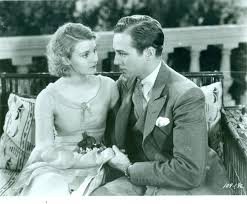
Now look at Lupita Tolvar in the same role, but in the Spanish version shot at night. Note the obvious differences in her nightgown and cleavage. The Spanish version for the time is a very sexy interpretation in compassion to the more famous Tod Browning film.

Adding to the production costs on "The Big Trail" was not one, but four Foreign market versions with cast and crew authorized by William Fox. These were the French film called "La Piste des geants" directed by Pierre Couderec, the German version "Die Grose Fahrt" directed by Lewis Seiler and Raul Walsh, the Italian version "ll grande sentiero" directed by Franco Carsaro who also apparently starred and finally the Spanish version "La Gran jomada" directed by David Howard, Samuel Schneider and Raul Walsh. All these films were shot in the normal 35 mm format and a little unbelievable, but true, at the same time the two John Wayne versions were being filmed. One can imagine just a little bit of confusion on the set.
As mentioned previously the 70 mm "Grandeur" Cinematographer on "The Big Trail" was Arthur Edeson. While for the 35 mm version the Cinematographer was Lucien N. Androit. Edeson had seven camera men assigned to him as did Androit for his version, No other department had separate crews.
Raul Walsh had six "Second Unit Directors" under him that included his younger brother George. The younger Walsh was an actor in 81 motion pictures from 1915 to 1935 and would only put on the directing hat for one other film by his brother in 1932.
The shooting of both films begin and the novice actor now called John Wayne wass faced with having to learn to act faster than to just:
He suddenly was in two separate motion pictures, because of the ratio of the two film stocks. There would be times when both the 35 mm and 70 mm camera's were next to each other photographing, but more times when they have to be used separately.
Take a look at this shot in "Grandeur" of the Wagon Train and the Indian Village.
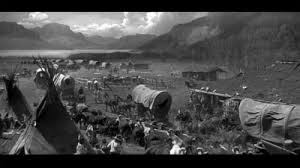
You can see the scope of the 70 mm lenses, but there is no way that more than half that shot will appear on 35 mm. The result is either shooting the sequence twice, or as Raul Walsh and his Cinematographers were able to do in some shots. Set up both camera's to photograph. However, this meant that the angle of the shot and the amount of image within the 35 mm frame became smaller and at times somewhat distorted,
Here's an example:
70 mm shot by Arthur Edeson and his crew
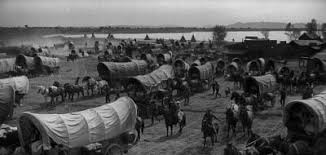
Beginning of same shot in 35 mm by Lucien N. Androit and his crew. You can spot the wagons positions in the above still.
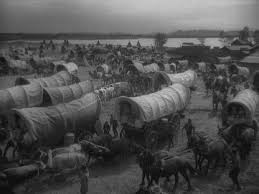
Another example of the differences between the two versions shot by Raul Walsh. The widescreen would have a scene where one actor was at one end of the picture frame talking to another at the frame's opposite end with action occurring between them. However, the 35 mm version would use fast cuts and close-ups for the conversation. Which brings me to the editing of the two features and their running times.
The only credit on "The Big Trail" for editing is Jack Dennis. Based upon the practice at the time it more than likely that he did his own editing on both versions. Researching I have found films Dennis worked on with one, or two other editors. Some he Supervised, but many others give Dennis sole credit. The two versions of "The Big Trail" is apparently such a film, or should that be films?
The running time for the 35 mm print is 108 minutes, but in 'Grandeur" the movie runs 122 minutes. One reason is that the widescreen version has several sequences designed solely to use the process and not necessarily be relevant to the story. However, there are some sequences in the 35 mm film that are not in the longer version. There appears to be no record as to why.
Two interesting facts have been mentioned about the film editing. The first is simply that for some reason when the film originally reached television it appears instead of using the widely distributed 35 mm cut that was readily available, The first television version was actually constructed from the widescreen version and had to have "pan and scan" scenes which distracted the viewer.Today the full "Grandeur" version is shown on Cable Stations as released.
The second interesting fact about the editing is the rumor that there was a 158 minute version that was used at the World Premiere of "The Big Trail". There are no surviving records to prove this cut existed at all. However, as a means to really show off the "Grandeur" process such a running time wouldn't have been out of the question.
According to "Motion Picture News" for May 24, 1930 Fox's "The Big Trail" had a budget of $1,250,000 in 1930 dollars. It is said, but again no records remain to support it, that the movie barely made back its total cost.
In my John Wayne film collection I have a two disk DVD that has both the 35 mm and 70 mm versions of "The Big Trail". I recommend it to anyone who is interested in John Wayne, Motion Picture History and Director Raul Walsh's work. I suggest that you first watch the film in its 35 mm release and then in William Fox's "Grandeur". Watching "The Big Trail" this way will make you appreciate what he had accomplished in 1930 and wonder were the film industry could have gone, if the Stock Market hadn't crashed and "The Great Depression" come on America. Today you go to see a motion picture without questioning the size of the screen. Widescreen is as common now as 35 mm was in 1930.
http://kinescopedreams.blogspot.com/2015/08/native-americans-hollywood-style-i.html
Cameraman Arthur Edeson's above article goes into the technical aspects of filming a motion picture in 70 mm versus 35 mm. What he does not speak about is that "The Big Trail" was actually two movie shoots referred to as a double shoot. Prior to this film 1929's "Song O'My Heart" was a double shoot, but the "Grandeaur" print has been lost. The film in the 35 mm version can be found on YouTube should my readers be interested.
The filming of "The Big Trail" started on location in Santa Fe, New Mexico. Most studios never left Southern California and this action by Raul Walsh was costly to Fox Studios, but added to the realism and justification to use "Grandeur". Additional filming locations included:
ARIZONA
Grand Canyon National Park
Yuma
CALIFORNIA
Buttercup Dunes (Imperial Valley)
Sequoia National Park (Three Rivers)
Sacramento River (Sacramento)
MONTANA
National Buffalo Range (Moise)
WYOMING
Grand Teton Pass
Jackson Hole
Yellowstone National Park
UTAH
Hurricane Bluffs
Zion National Park (Springdale)
St, George
As dubbing for Foreign Markets had not began in the 1930's. The normal practice was to shoot the motion picture with an appropriate Foreign language speaking cast and either a Foreign director, or one that spoke the required language using a Foreign crew. The most famous film shot this way was Universal Studios "Dracula" from 1931. During the daylight hours Tod Browning shot his movie starring Bela Lugosi and Helen Chandler. While at night using the same sets and scripts George Melford shot the Spanish language version starring Carlos Villiars. Who also appeared in the Spanish language version of the "Big Trail" and Lupita Tovar.
As "The Big Trail" was a pre-production code motion picture. There was a lot of latitude as related to censorship, but censorship was still imposed on it. While the Foreign market productions were free of any restraints. To illustrate that point I give you photos from the two productions of "Dracula" concerning the appropriate clothing worn by the leading ladies. This is the exact scene in each film version.
Helen Chandler in the Tod Browning film. Note the high neckline of her nightgown which style was carried through all her clothing.
Now look at Lupita Tolvar in the same role, but in the Spanish version shot at night. Note the obvious differences in her nightgown and cleavage. The Spanish version for the time is a very sexy interpretation in compassion to the more famous Tod Browning film.

Adding to the production costs on "The Big Trail" was not one, but four Foreign market versions with cast and crew authorized by William Fox. These were the French film called "La Piste des geants" directed by Pierre Couderec, the German version "Die Grose Fahrt" directed by Lewis Seiler and Raul Walsh, the Italian version "ll grande sentiero" directed by Franco Carsaro who also apparently starred and finally the Spanish version "La Gran jomada" directed by David Howard, Samuel Schneider and Raul Walsh. All these films were shot in the normal 35 mm format and a little unbelievable, but true, at the same time the two John Wayne versions were being filmed. One can imagine just a little bit of confusion on the set.
As mentioned previously the 70 mm "Grandeur" Cinematographer on "The Big Trail" was Arthur Edeson. While for the 35 mm version the Cinematographer was Lucien N. Androit. Edeson had seven camera men assigned to him as did Androit for his version, No other department had separate crews.
Raul Walsh had six "Second Unit Directors" under him that included his younger brother George. The younger Walsh was an actor in 81 motion pictures from 1915 to 1935 and would only put on the directing hat for one other film by his brother in 1932.
The shooting of both films begin and the novice actor now called John Wayne wass faced with having to learn to act faster than to just:
sit good on a horse and point.The reason:
He suddenly was in two separate motion pictures, because of the ratio of the two film stocks. There would be times when both the 35 mm and 70 mm camera's were next to each other photographing, but more times when they have to be used separately.
Take a look at this shot in "Grandeur" of the Wagon Train and the Indian Village.
You can see the scope of the 70 mm lenses, but there is no way that more than half that shot will appear on 35 mm. The result is either shooting the sequence twice, or as Raul Walsh and his Cinematographers were able to do in some shots. Set up both camera's to photograph. However, this meant that the angle of the shot and the amount of image within the 35 mm frame became smaller and at times somewhat distorted,
Here's an example:
70 mm shot by Arthur Edeson and his crew
Beginning of same shot in 35 mm by Lucien N. Androit and his crew. You can spot the wagons positions in the above still.
Another example of the differences between the two versions shot by Raul Walsh. The widescreen would have a scene where one actor was at one end of the picture frame talking to another at the frame's opposite end with action occurring between them. However, the 35 mm version would use fast cuts and close-ups for the conversation. Which brings me to the editing of the two features and their running times.
The only credit on "The Big Trail" for editing is Jack Dennis. Based upon the practice at the time it more than likely that he did his own editing on both versions. Researching I have found films Dennis worked on with one, or two other editors. Some he Supervised, but many others give Dennis sole credit. The two versions of "The Big Trail" is apparently such a film, or should that be films?
The running time for the 35 mm print is 108 minutes, but in 'Grandeur" the movie runs 122 minutes. One reason is that the widescreen version has several sequences designed solely to use the process and not necessarily be relevant to the story. However, there are some sequences in the 35 mm film that are not in the longer version. There appears to be no record as to why.
Two interesting facts have been mentioned about the film editing. The first is simply that for some reason when the film originally reached television it appears instead of using the widely distributed 35 mm cut that was readily available, The first television version was actually constructed from the widescreen version and had to have "pan and scan" scenes which distracted the viewer.Today the full "Grandeur" version is shown on Cable Stations as released.
The second interesting fact about the editing is the rumor that there was a 158 minute version that was used at the World Premiere of "The Big Trail". There are no surviving records to prove this cut existed at all. However, as a means to really show off the "Grandeur" process such a running time wouldn't have been out of the question.
According to "Motion Picture News" for May 24, 1930 Fox's "The Big Trail" had a budget of $1,250,000 in 1930 dollars. It is said, but again no records remain to support it, that the movie barely made back its total cost.
In my John Wayne film collection I have a two disk DVD that has both the 35 mm and 70 mm versions of "The Big Trail". I recommend it to anyone who is interested in John Wayne, Motion Picture History and Director Raul Walsh's work. I suggest that you first watch the film in its 35 mm release and then in William Fox's "Grandeur". Watching "The Big Trail" this way will make you appreciate what he had accomplished in 1930 and wonder were the film industry could have gone, if the Stock Market hadn't crashed and "The Great Depression" come on America. Today you go to see a motion picture without questioning the size of the screen. Widescreen is as common now as 35 mm was in 1930.

